|

by Lisa Rome
from
UnicusMagazine Website
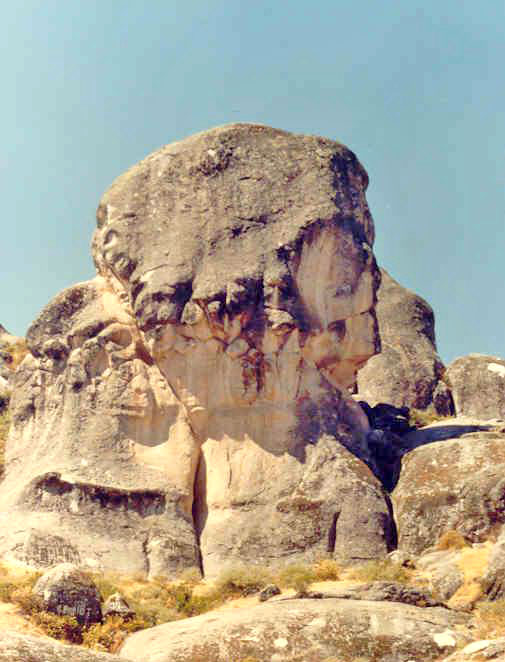
Monument of Humanity
"Our discoveries
were made like this: Observing rocks near where thousands of
people lived, but they didn’t see them because they lacked faith
in the magic world and in the works of art left by a former
humanity which created and respected this world and produced
these incomparable works of art, but left no signature. The
artistic work was the rhythm of life, like heartbeats, or
breathing, or walking on this earth. It was a work of magic.
Humanity has forgotten all of this and considers going to the
moon much more important. It cannot explain the appearance of
these genius men who break all barriers to arrive at surprising
results without seeking for himself, and without listening to
dogmatic voices - which try to reduce to words that which has no
name.
We demonstrate in this book that the carvings and the sculptures
made in the natural rock, to be seen from a point of view or a
certain direction, and in conditions of special lighting, give
credit to a style that could only be expressed by men of
profound pantheist faith. The technique of these sculptors has
not been repeated in subsequent history.
These works are found in different places on earth, very removed
from one another, repeating the same symbols, and with one thing
in common: they are found around sacred mountains, temples of
lost humanity, so they won’t be forgotten and that they may
serve one more time to purify and save humanity."
These are the words of
Daniel Ruzo, found in the introduction of his book, "Marcahuasi The
Story of a Fantastic Discovery", first published in the Spanish
language in 1974. Ruzo (1900-1993) was certainly one of the
grandfathers of the New Age.
Marcahuasi is a unique mountain top, geologically unlike any of the
surrounding Andes, located 80KM north east of Lima, Peru. Daniel Ruzo, a genius by his own definition, has dedicated his life to the
study of sacred sites around the world. Today he continues his
life’s work at his home in Cuernavaca, Mexico; close to Tepotzlan,
another sacred mountain site.
The works of art referred to in the introduction of his book are the
monuments, monolithic sculptures, some megaliths, which are found on
top of Marcahuasi. There are hundreds of these monuments on the
41/2KM x 1KM plateau. They are so large, so clear that even someone
who isn’t a seeker cannot argue their existence. The "monuments
repeating the same symbols" are found in Tepotzlan and Guanajuato,
Mexico; Rio de Janeiro and Vila Velha in Brazil; Lake Titicaca, San Cristobal and Los Angeles in
Peru; Stonehenge and Avebury in
England; The Sacred Valley of the Kings in Egypt; the Carpatos
mountains in Rumania; and Kakadu National Park in Australia to name
a few. Although Daniel Ruzo also studied the monuments of the
Easter
Islands, he made no conclusion about their origin. All of the
monuments in all of these places, according to Ruzo, were created by
a humanity that lived before the time of the flood for which Noah
built his arc.
The monuments mark the general area of the caves and caverns that
made possible the salvation of our humanity, and those previous,
during the time of the great catastrophes. The last catastrophe was
a flood and Noah’s arc is merely a metaphor for the caves and
caverns, marked by the monuments, all over the world. According to
Ruzo the catastrophe (a fire, previous to the flood) was survived by
Adam and Eve by living deep inside caverns.
Daniel Ruzo formed his theory of humanity in the 1920’s. It was his
life’s work to support his theory. Using the Bible, myths and
legends from around the world, the works of Nostradamus, astrology,
and other sources, he sights evidence that illuminates his belief.
The theory is:
-
Human life on earth has been made up of five
humanities, each humanity lasts 8,608 years and is made up of four
sun cycles of 2,125 years each.
-
We are in the fifth humanity.
-
Every
8,608 years the earth suffers a catastrophe.
-
Following the zodiac,
humanities have survived catastrophes of earth, fire and water.
According to Ruzo the next catastrophe will be by air and will occur
between the years 2127 and 2137.
The monuments around the world mark the entrances to the caves and
caverns that will make possible the salvation of the seeds of
humanity. As the monuments are only indicators that these
all-important entrances are in the general area, we, the faithful,
must make it our mission to locate the entrances, in time to prepare
the caves and caverns, before the next catastrophe and save the
seeds of humanity as they have been saved by the previous
humanities. The universal symbols referred to in the introduction of
"Marcahuasi" are the key to understanding how to locate the
entrances on the sacred mountains. As the entrances have yet to be
found, we must work to "break the code" of the symbols to find them.
Daniel lived on Marcahuasi for a period of nine years beginning in
1952. He took thousands of photographs of the monuments during that
time. He found that depending on the time of day and the time of
year, in the light of the sun, the moon, or the stars, even in
shadow, that different sculpted images can be seen, even in the same
monument. The main monument, the Monument of Humanity, has fourteen
faces visible by the light of the sun and two visible only by the
light of the moon. Ruzo’s photos demonstrate very clearly the many
different faces of Marcahuasi. He claims that even though his work
went on for a lengthy nine years that he has studied a mere ten
percent of the figures. Other important monuments rare the Condor,
whose form changes every sixty degrees, and the Feline which can be
seen only during the week of the winter solstice.
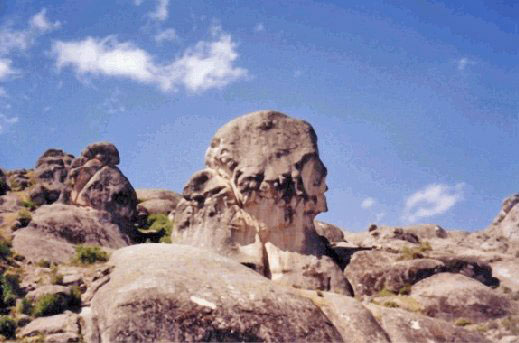
There are many other important facets of
Marcahuasi, all pieces of
an incredible, complex puzzle. There are twenty-two energy vortexes
called "cruzes" or crosses, made up of three distinct types of
energy.
-
There are three of the first type which are found in areas
of limited access on the plateau, limited to those prepared to be
near such powerful energy.
-
The second type of cross, of which there
are seven, are crosses betoken to the days of the week.
-
There are
twelve crosses of the third type which have to do with the phases of
the moon.
-
Each cross has a specific healing power.
-
The crosses which
are easily visible on the plateau have an undeniable energy that can
be felt without any special preparation or sensitivity.
Carlos Seclan, a Peruvian disciple of
Daniel Ruzo, had an
extraordinary experience at one of the vortexes of Marcahuasi. He
had been studying Marcahuasi for fifteen years when he had a car
accident, which left him paralyzed, in bed, for eleven months. With
the finest doctors in Peru available to treat him, he was told that
he could not be healed and would never walk or even sit up again.
After having studied the energies of the stones and vortexes of Marcahuasi, he knew that there had to be some way to cure his broken
back with the profound forces of the mountain. He knew that on a
certain day, at a certain hour, at a certain vortex, that there
would be the appropriate energy to heal himself. He convinced his
friends to carry him up the mountain, to the designated vortex,
where they left him, alone, for seven days.
On the seventh day, a normal looking Peruvian man, stranger to
Carlos, appeared and they spoke about Carlos’ problem. The man then
began to demonstrate some exercises, which Carlos followed. As he
moved, he felt a heat rising through his body starting at his toes.
He heard a distinct buzzing noise and felt a tingling at the same
time. When the heat and buzzing sensations reached the top of his
head, about twenty minutes later, he felt as though a light entered
the top of his head.
The light made him sleepy and he fell asleep. When he woke up,
several hours later, he was surprised to realize that not only could
he sit up, but stand up as well. The man was gone, and Carlos walked
down the mountain alone to join his friends who had been waiting for
him at the cabana, the house that Daniel Ruzo built behind the
Monument of Humanity.
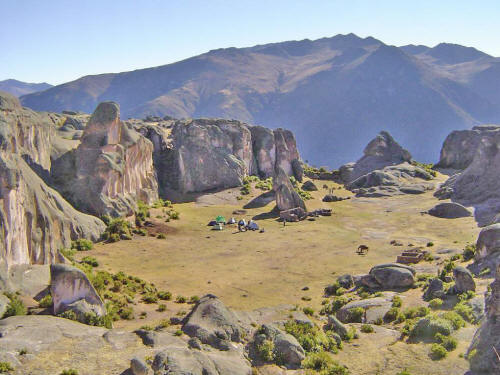
Carlos is the most important scholar of the
vortexes of Marcahuasi.
He only shows five of the vortexes to others. Two of the vortexes
are easy to find on the plateau: one is located beneath the Feline,
and the other, marked with a white X, is in the center of the
plateau, at the edge of a precipice. Carlos first went to Marcahuasi
in 1973, on a hunting trip. He says that before he went, he had seen
Marcahuasi in his dreams, and when he arrived, he knew exactly where
to go for water.
Marcahuasi is also a famous location for UFO sightings. The
villagers in the town below Marcahuasi, San Pedro de Casta, accept
UFO sightings as a normal occurrence. When asked if they believe in
UFO’s, they react as though it was a strange question - as though
they had been asked if they believe in cows.
Moises Bautista, former president of the community, tells of an
encounter he had in August of 1963. The night was clear with a full
moon. At about 2:00 a.m., he was walking near some ruins on his way
to check his cows on the plateau. He saw a "car like" vehicle come
out of the sky and land about 20M in front of him. He hid beneath a
tomb as the encounter unfolded.
The vehicle was about 3M in diameter with six round "fluorescent"
lights. Out of the vehicle came five beings, each approximately lM,
20cm tall. They were wearing orange/brown body suits and boots. They
emerged from a portal of the vehicle made of clear material. They
walked around and touched stones on the ground as though they were
inspecting them. They then returned to the vehicle and departed,
flying north, the same direction from which they came. The whole
encounter lasted three minutes. Moises speaks freely about his
encounter, as it is not considered a crazy subject in the town of
San Pedro.
Others in San Pedro who have had sightings include the town baker.
He says that he regularly sees a silver metallic disc with
multi-color lights flying over Marcahuasi. He believes that the
UFOs have a regular pattern, appearing at the end of the month. The
baker, Moises Bautista, and many others in San Pedro, including the
town’s youngest children had a sighting, at night/of a disc that
flew over the town. The children animatedly tell of the "flying
saucer" or "planet" with colorful lights that flew over their heads
in 1988.
San Pedro de Casta is the folkloric Andean village through which one
must pass before arriving in Marcahuasi. Here, one can hire burros
to carry supplies and equipment to the plateau, a three and a half
hour walk up the mountain. The people of San Pedro are the spiritual
guardians of the "meseta" of Marcahuasi. It is their responsibility
to see that those who are welcomed to the meseta feel safe and cared
for during their stay.
The people of San Pedro are "campesinos" or peasants. They make
their communal living (income) by farming the terraced land of the
surrounding mountains, as their ancestors did for thousands of years
before them. A total of twenty tons of corn, alfalfa, potatoes, and
other crops are exported every year. More interesting, however, is
that they export FORTY tons of medicinal plants which grown wild on
the surrounding mountains as well as Marcahuasi itself. The few
available plants found in the area seem to cover all of their needs.
The people of San Pedro claim that the plants are ancient.
Some of the medicinal plants found in the area of San Pedro de Casta
and their uses are: Valeriana, the natural source of our synthetic
Valium, is a ground cover with little yellow flowers. A tea made
from Valeriana’s flowers is a relaxant. Margerita Silvestre’s brown
or yellow flowers made into a tea, helps to lower high blood
pressure. Tarwi’s blue flowers and leaves, but not the seed, made
into a tea is helpful to combat chills and fever. A combination of
the leaves of the Chunchu plant’s leaves and those of the Gasengasa
boiled in milk, and drunk, is good for the discomforts of puberty.
Tipta tea, made from the small leaves and yellow flowers of the
plant, is almost a miracle cure for headache. Headaches are a
frequent symptom of altitude sickness, easily contracted at the
4000M altitude of Marcahuasi. A combination of Taiya and
Chinchilcoma leaves mashed with alcohol and applied in a poultice to
a swollen part of the body is a rapid remedy for swelling.
Marcahuasi also has its myths and legends. The place on the meseta
with the most interesting stories is the "Infernillo", or the
infernal place. It is a large rock crevasse about twenty feet deep.
It is said that anyone who dares to jump across the Infernillo will
be "swallowed up" and taken inside the earth, never to return again.
Another myth surrounding the Infernillo is that if a person walks
into the base of the crevasse, he will be taken inside the earth, go
through the mountain, and come out at the mouth of a river far away.
The person would never be the same again and unable to reenter
society. He would shy away from humans as wild animals do. The
locals do regard these as myths and readily jump over the gap of the
Infernillo.
Soxtacuri was the living God who ruled over the entire plateau of Marcahuasi. Every January he would meet with all of the chiefs of
the surrounding valleys to exchange ideas. These legendary meetings
are remembered today in a ritual performed every January 5 by the "curandero"
or shaman of San Pedro de Casta, Paolino Gonzales, in front of the
monument the Bruja.
Every year the people who lived in Marcahuasi would offer the
sacrifice of a woman to their beloved Soxtacuri. One year the people
failed to make their offering, and in anger, he left and moved to
Bolivia. It is said that when Soxtacuri left, his Godless people
also moved from the plateau. By the time the conquistadores arrived,
new peoples populated the meseta of Marcahuasi. Soxtacuri’s house
and throne still remain on the plateau.
The conquistadores again displaced the people of Marcahuasi. Some of
their descendants live in San Pedro de Casta. The Spanish displaced
people all over Peru and put them in new villages so that they could
enforce order and force Catholicism upon them. They taught Spanish
and catechism to the indigenous Peruvians. The conquered people
living nearest Lima lost their native language: Quechua. Most names
of rivers, mountains and Gods are in Quechua, which despite the
efforts of the brutal conquistadores, is still the number two
language in Peru. Marcahuasi, in Quechua, simply means house/town.

There are five towns of ruins on the plateau of Marcahuasi. It is
thought that at one time, probably in the fourteenth century, that
thirty thousand people populated the towns of Marcahuasi. Judging
from one prominent ruin, the "Fortaleza" or fortress
(above image), which occupies
the second highest hill of the plateau, the people were warriors,
concerned with surveying and protecting their territory.
The Incas did not arrive until the majority of the towns had been
abandoned and the ruins converted into "pacarinas", dedicated to the
ancestors of the departed people. What the Incas did find were
constructions of angular stones put together with mud, forming
patios, rooms, corridors and tombs. The tombs or "chulpas"
(below image) are still
scattered all over the plateau, and mark the most sacred spot in
every town. Unfortunately, most of the chulpas have been robbed of
their mummies and offerings which included: jewelry, pottery and
textiles.
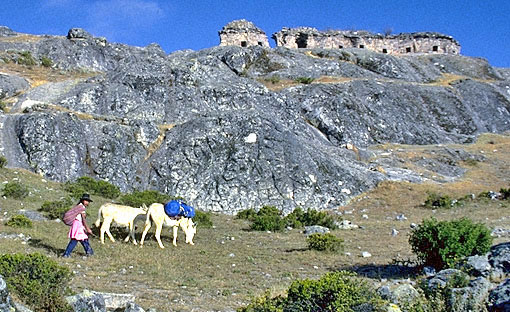
However, an impressive display of mummies can be viewed,
with permission, at the high school in San Pedro de Casta. No
organized excavation of any kind has ever been done in the towns of
Marcahuasi. The Peruvian government has no funds and all excavations
going on at this time in Peru are funded by foreign foundations.
The terrain of Marcahuasi is by no means welcoming, it is rocky and
barren. The weather in the dry season is hot and sunny in the
daytime and very cold at night. There is little shade from the sun.
In the rainy season it is virtually impossible to walk around the
plateau, as it converts into a giant mud puddle. Nonetheless,
Marcahuasi has an indescribable magnetism that brings people back
again and again.
There are some very attractive features on this 4000M mountain as
well. The silence is moving to the soul. At nighttime, with the
stars above, as both the ceiling and the walls of the plateau, one
has the sensation of being in a large room. The views, of the sea of
clouds below the mountain and the islands of mountain tops peeking
out, are breathtaking. The not so occasional sight of a condor, or
two or three condors flying overhead is unique.
There are a few forms of animal life on the plateau. The gray fox
lives in a rocky den and is rarely seen. The "viscacha", and odd
cross between a rabbit and a squirrel is the most populous animal of
Marcahuasi. "Puma" or mountain lions, live at altitudes higher than
Marcahuasi, but come down to the plateau during the rainy season.
All of these animals are hunted as their meat is enjoyed as a
delicacy by the locals.
In recent years the monuments and tombs have been greatly disturbed
by the 3,000 to 4,000 tourists each year who make weekend trips to
the mountain. The guardians from San Pedro de Casta cannot control
the destruction of the monuments that have been there for thousands
of years. Unfortunately, the guardians are dependent on the income
brought to the town by the destroyers of the meseta, who rent their
burros and buy a few supplies, such as water, to take up to
Marcahuasi.
The trip from Lima to San Pedro de Casta, by car, takes about five
hours. There are several Andean hotels in San Pedro, should one wish
to spend the night. It is advisable to bring a sleeping bag and a
personal food supply. The walk up to the meseta of Marcahuasi takes
about three and one half-hours. There are a few horses available for
hire that can substitute for one’s own feet going up the hill.
Burros for hire are too small to carry an average person. -The ideal
time to go to Marcahuasi is from April to October. The most
important festival, the "Fiesta del Agua", takes place every year at
the beginning of October and lasts for eight days. There are also
ceremonies on the plateau for the winter solstice.
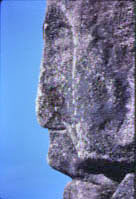  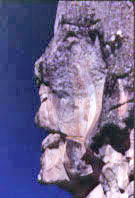
|








